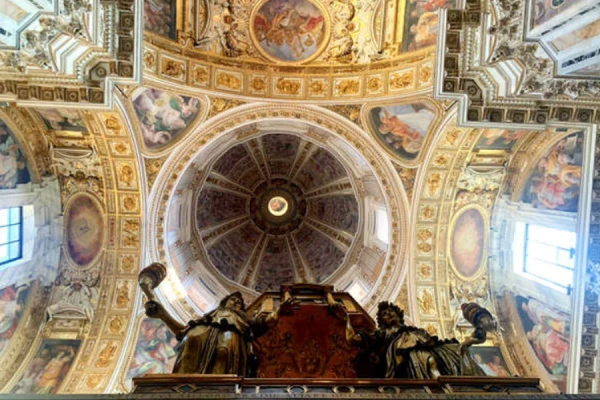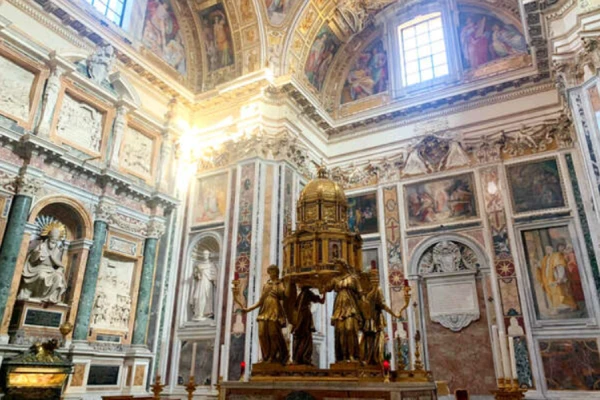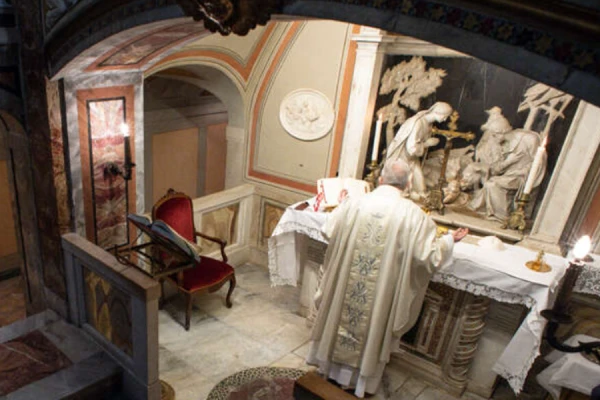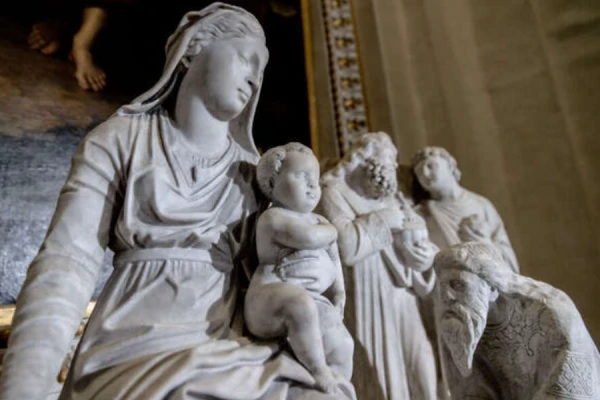 Courtney Mares.
Courtney Mares.
Pope Sixtus V restored the crypt Chapel of the Nativity to the form seen today between 1585 and 1590 as he built the basilica’s Sistine chapel.
In St. Mary Major’s Sistine chapel, where the Nativity scene is located, visitors can also see the first tabernacle to be made according to the precepts of the Council of Trent and an altar dedicated to St. Jerome.
 Courtney Mares.
Courtney Mares.
Tradition holds that St. Jerome’s relics were brought from Bethlehem to Rome shortly after the relic of the manger and are now located either in the main altar or the side chapel in the Basilica of St. Mary Major where the first Nativity is currently displayed.
(Story continues below)
The relic of the manger is now kept in a niche below the main altar of the basilica. It was moved by Pope Pius IX from the Chapel of the Nativity to its current location under the altar in the 19th century.
Pope Francis visited the Basilica of St. Mary Major during Advent 2021 on the Solemnity of the Immaculate Conception.
 Vatican Media.
Vatican Media.
The pope made a pilgrimage to the Italian town of Greccio in Advent 2019 to sign an apostolic letter on the meaning and importance of Nativity scenes in the location where St. Francis of Assisi created the first Nativity scene in 1223.
The letter, Admirabile signum, recalled the story behind St. Francis’ first living Nativity scene, or crèche. The saint asked a friend 15 days before Christmas to help him prepare “to bring to life” the memory of Christ’s birth in Bethlehem.
“When St. Francis arrived, he found a manger full of hay, an ox, and a donkey,” the pope wrote. “All those present experienced a new and indescribable joy in the presence of the Christmas scene. The priest then solemnly celebrated the Eucharist over the manger, showing the bond between the Incarnation of the Son of God and the Eucharist.”
“At Greccio there were no statues; the Nativity scene was enacted and experienced by all who were present.”
Thomas of Celano, the first biographer of St. Francis, wrote that someone present at the Mass had a vision of the baby Jesus himself lying in the manger.
Pope Francis wrote: “In a particular way, from the time of its Franciscan origins, the Nativity scene has invited us to ‘feel’ and ‘touch’ the poverty that God’s Son took upon himself in the Incarnation. Implicitly, it summons us to follow him along the path of humility, poverty, and self-denial that leads from the manger of Bethlehem to the cross.”
This is an updated version of an article originally published by Catholic News Agency on Dec. 23, 2020.
Courtney Mares is a Rome Correspondent for Catholic News Agency. A graduate of Harvard University, she has reported from news bureaus on three continents and was awarded the Gardner Fellowship for her work with North Korean refugees.




 Courtney Mares.
Courtney Mares.
 Courtney Mares.
Courtney Mares. Courtney Mares.
Courtney Mares. Vatican Media.
Vatican Media.


